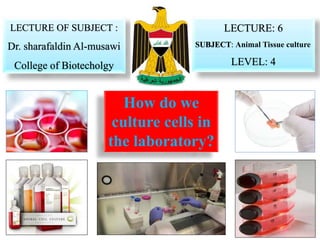
6 how do we culture cells in the laboratory lecture 6
- 1. How do we culture cells in the laboratory? LECTURE OF SUBJECT : Dr. sharafaldin Al-musawi College of Biotecholgy LECTURE: 6 SUBJECT: Animal Tissue culture LEVEL: 4
- 2. Revive frozen cell population Isolate from tissue Maintain in culture (aseptic technique) Sub-culture (passaging) Cryopreservation Count cells Containment level 2 cell culture laboratory Typical cell culture flask ‘Mr Frosty’ Used to freeze cells
- 3. Why passage cells? To maintain cells in culture (i.e. don’t overgrow) To increase cell number for experiments/storage
- 4. Materials Media– pre-warmed to 37ºC (refer to the ECACC Cell Line Data Sheet for the correct medium) 70% ethanol in water PBS without Ca2+/Mg2+ 0.25% trypsin/EDTA in HBSS, without Ca2+/Mg2+ Trypsin Soybean trypsin Inhibitor
- 5. Equipment Personal protective equipment (sterile gloves, Laboratory coat, safety visor) Waterbath set to appropriate temperature Microbiological safety cabinet at appropriate containment level CO2 incubator Pre-labeled flasks Marker Pen Pipettes
- 6. 1. View cultures using an inverted microscope to assess the degree of confluency (70-90%) and confirm the absence of bacterial and fungal contaminants. 2. Remove spent medium. 3. Wash the cell monolayer with PBS without Ca2+/Mg2+ using a volume equivalent to half the volume of culture medium to remove dead cells and serum. (Repeat this wash step if the cells are known to adhere strongly). Procedure
- 7. 4. Pipette trypsin/EDTA onto the washed cell monolayer for digests protein-surface interaction to release cells (collagenase also useful) using 1ml per 25cm2 of surface area. • Rotate flask to cover the monolayer with trypsin. Procedure
- 8. 5. Return flask to the incubator and leave for 2-10 minutes (depending on cell type). 6. Examine the cells using an inverted microscope to ensure that all the cells are detached and floating. The side of the flasks may be gently tapped to release any remaining attached cells. Procedure
- 9. 7. Resuspend the cells in a small volume of fresh serum- containing medium to inactivate the trypsin. (Remove 100-200uL and perform a cell count). 8. Transfer the required number of cells to a new labeled flask containing pre-warmed medium. (refer to Cell Line Data Sheet for the required seeding density). • Most cell lines will adhere in approx. 3-4 hours Procedure
- 10. Why EDTA in trypsin? EDTA enhances trypsin activity. Actually trypsin/EDTA is a combined method for detaching cells. Trypsin cuts the adhesion proteins in cell-cell and cell-matrix interactions EDTA is a calcium chelator, which integrins needs to interact with other proteins for cell adhesion. no calcium = no cell adhesion. EDTA: can decrease the clumping of cells.
- 11. • Some cultures whilst growing as attached lines adhere only lightly to the flask, thus it is important to handled the flask with care to prevent the cells detaching prematurely. • Although most cells will detach in the presence of trypsin alone the EDTA is added to enhance the activity of the enzyme. Key Points
- 12. Key Points • Trypsin is inactivated in the presence of serum. Therefore, it is essential to remove all traces of serum from the culture medium by washing the monolayer of cells with PBS without Ca2+/Mg2. • Cells should only be exposed to trypsin/EDTA long enough to detach cells. Prolonged exposure could damage surface receptors. • Trypsin should be neutralized with serum prior to seeding cells into new flasks otherwise cells will not attach.
- 13. • Trypsin may also be neutralized by the addition of soybean trypsin inhibitor , where an equal volume of inhibitor at a concentration of 1mg/ml is added to the trypsinised cells. • The cells are then centrifuged, resuspended in fresh culture medium and counted . • This is especially necessary for serum-free cell culture. Key Points
- 14. Confluency • Confluency referring to the proportion of the surface which is covered by cells. • For example, 50 percent confluence means roughly half of the surface is covered and there is still space for cells to grow. • 100 percent confluence means the surface is completely covered by the cells, and no more space is left for the cells to grow as a monolayer.
- 15. • Cells are typically passaged before becoming fully confluent in order to maintain their proliferative phenotype. • Cells to be kept in healthy & in growing state have to be sub-cultured or passaged , It’s the passage of cells when they reach to 75-90% confluency in flask/dishes/plates. Confluency
- 16. 30 % confluency10 % confluency 20 % confluency 40 % confluency 50 % confluency 60 % confluency 70 % confluency 85 % confluency 100 % confluency
